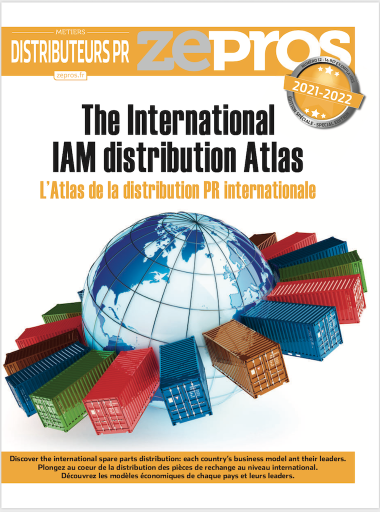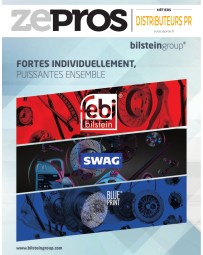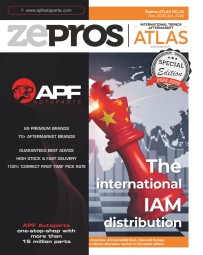
[Atlas] ZF Aftermarket : “Alongside the IAM throughout the technological transition”
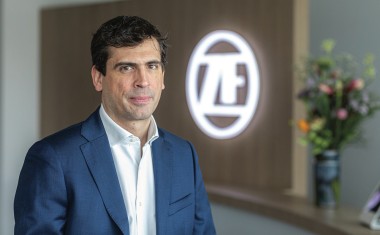
Philippe Colpron, Zf Aftermarket director , takes stock of the past two years and gives to Zepros his vision for the future.
How did you cope with the pandemic period?
Philippe Colpron: The sudden increase in demand for spare parts created a strain on OEMs. The equation became even more complex with the increase in logistics costs and shortages. By securing additional production capacity from the outset, we were able to secure good service rates, which enabled us to win contracts. While in 2020 the ZF Aftermarket business was affected by the pandemic, 2021 was an excellent year. In some regions of the world, such as Europe and Asia, we achieved record results.
How did you deal with shortages?
P. C. : In the first half of 2021, it proved extremely difficult to be fully serviced by our suppliers due to the successive crises. But our early anticipation with huge orders paid off. The ZF factories gradually increased their capacities and reduced the order backlog at ZF Aftermarket.
Did you increase your prices in 2021? And will you do so in 2022?
P. C.: The global economy is affected by increasingly volatile market conditions. We have had to adjust our prices in order to secure supply. We will closely monitor the current situation and continue to optimise costs where possible, in order to provide our clients with the value and service they expect.
For reasons of increasing the cost of the global supply chain as well as for CSR reasons, do you plan to relocate at least part of your production to Europe?
P. C.: We are serving a diverse customer landscape in over 115 countries. Therefore, we have production sites (and service locations) all around the globe, wherever our customers need us – this includes of course Europe.
What were your 2021 priority issues in terms of business aftermarket? And what are those for 2022?
P. C.: We operate in an ever-evolving, increasingly complex landscape, so we strive to support our customers with comprehensive solutions. Digital services will take a larger precedence in our offering, allowing us to cater to our customers’ needs in a more dynamic and intuitive manner. In addition, the amount of new onboard technologies within vehicles is growing very fast while increasingly connected and autonomous functionalities are gaining more and more traction. Disruptive new mobility concepts are requiring shifts in business models across many industries.
We see our role in navigating our partners through the transformation - as we are actively shaping new technologies for leading mobility manufacturers worldwide, we are well equipped to accompany our customers on this journey.

Where do you stand in the area of digitalization and technological transformation?
P. C.: Our main goal remains to offer digitalization to maximize convenience for our customers. We completely revised our Aftermarket portal: Workshops, distributors, fleet operators and ZF service partners benefit from the many user-friendly features. Another aspect is the digitization of our trainings. Accelerated by the effects of the pandemic our training experts have developed online training courses in which valuable know-how is conveyed to our customers virtually in a completely contactless manner.
Last but not least especially in the field of CV we launched new digital solutions for fleets, workshops and distributors – enabling a safer, greener and leaner transport industry. A new product which caters to the connected Next Generation Aftermarket is ZF Bus Connect. This is a fleet management tool that enables public transport or private bus operators to enhance and improve efficiency and performance of their fleets. We are also always on the lookout for partnerships to further expand the offering for our customers in this area. Such as the cooperation with Goodyear we have started this year, which enables us to offer an integrated fleet and tire management solution for trailers.
In your opinion, will predictive and prescriptive after-sales solutions be accessible to your independent aftermarket customers?
P. C.: We are strongly dedicated to ensuring that independent workshops will benefit from predictive maintenance offer remote diagnostics systems such as Trailer Pulse for trailers, Transics for Trucks and Bus Connect for Busses. Through our services for Autonomous Transport Systems (autonomous shuttles), we can give workshops a glimpse of the service of the future – already today. It makes the changes in mobility perceptible with more e-vehicles, predictive maintenance, and, in the long term, also autonomous vehicles. As ZF Aftermarket, we provide services for shuttles such as the maintenance of software or infrastructure. We then “translate” our service know-how and experience into predictive maintenance for our workshop partners so they can prepare at an early stage for the requirements brought on by the Next Generation of. Our trainings always aim to prepare workshops in the best possible way for the challenges of the future.
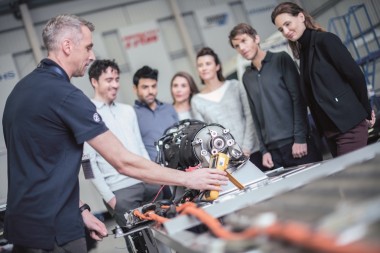
So electromobility is a major pillar of ZF’s own transformation?
P. C.: Indeed, we are highly committed to supporting the evolution of the global Aftermarket. As part of a leading OE technology supplier, we see our role as ZF Aftermarket to educate our partners as new technologies are being released. With the ZF Group being at the forefront of developments when it comes to electronic vehicles, we can offer a wide array of services to workshops, including education and training but also service, repair and parts. This includes classic parts that will still be relevant in the foreseeable future such as steering and suspension parts under the Lemförder and Sachs brands, but also brakes which evolve with the vehicle transformation. Leading manufacturers today require low-noise brake pads which we supply under our TRW brand.
Our offering also includes trainings like our high-voltage trainings: Service on e-vehicles may only be performed by personnel who have been specially trained for this purpose. In this area, ZF Aftermarket offers both pure online training and training based on the blended learning approach, consisting of classroom and online training.
We are continuously evolving to become an E-Mobility One-Stop-Shop for the Aftermarket. Our recently launched cooperation with CATL is another step on this pathway.
How do you position yourself in relation to new automobile uses?
P.C.: We fully agree that changing customer expectations and behaviors as well as the increasingly sophisticated demand of our fleet customers require new service offerings. That’s why we have created an offering package called fleet-solutions in order to create a value proposition consisting of parts and digital solutions – for commercial vehicle fleets but also other segments.
The increased use of vehicles in fleets has different effects, predictive maintenance for example is key to increasing the uptime of vehicles. Our connectivity tools offer live data evaluation on a per-vehicle basis which allows optimized driving and route plans and reduced fuel consumption. Plus, the predictive detection of damage or wear and tear of consumable items as well as diagnosis and repair "over the air" to reduce downtime and increasing safety and efficiency.
